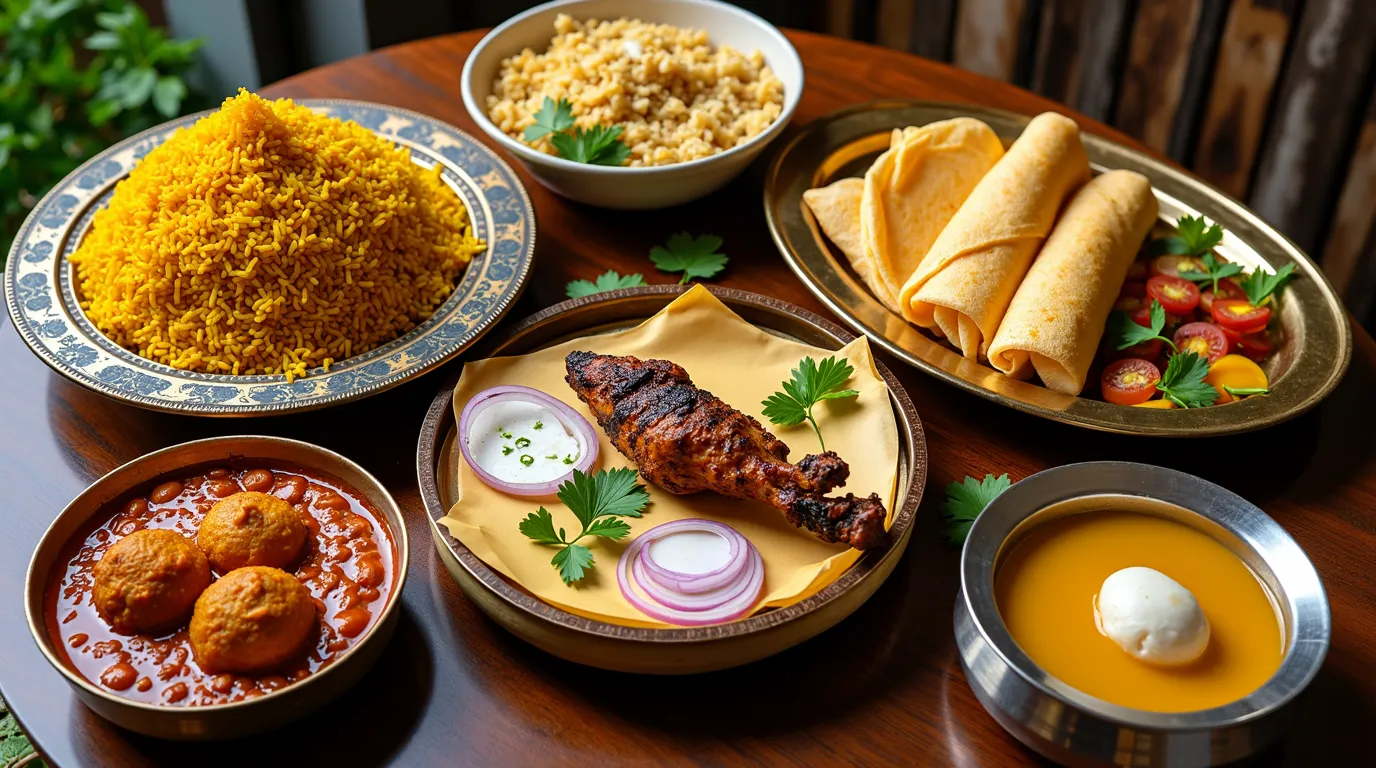Table of Contents
Introduction
Spanning over 3.28 million square kilometers, India is home to an incredibly diverse population, representing multiple religions, languages, and cultural identities. This diversity is nowhere more evident than in its food. Indian cuisine is not monolithic; it changes from state to state, city to city, and sometimes even from one family kitchen to another. Each region has its own cooking style, signature spices, and local specialties, all woven into centuries-old traditions.
However, there are some unifying themes that make up the essence of Indian cooking: the masterful use of spices, a deep-rooted relationship with agriculture and seasonality, and a cultural emphasis on food as a form of celebration and hospitality. Whether you sample a sumptuous feast at a wedding or enjoy a simple home-cooked thali (a platter with multiple dishes), you will experience an enduring Indian tradition: sharing food as a communal act.
In this extensive article, we will explore how Indian cuisine has evolved, shaped by geography and a long history of interactions with various cultures and empires. We will delve into the country’s most iconic ingredients, highlight must-try dishes, discuss differences between regions, and examine how modern trends and fusion experiments are altering culinary landscapes. By the end, you will gain not only a deeper appreciation for Indian food but also a desire to explore it personally—perhaps by cooking a traditional dish at home or visiting a local Indian restaurant. Let’s begin this journey into the fragrant, colorful world of Indian cuisine.
Culinary Context and History
How Indian Cuisine Has Developed Over Time
The history of Indian cuisine is a tapestry woven from many threads: indigenous cooking practices, foreign influences through trade and conquests, and religious prescriptions governing food choices. It is believed that the foundations of Indian culinary traditions date back at least 5,000 years, originating in the Indus Valley Civilization. Archaeological evidence suggests that the people of the Indus Valley cultivated wheat, barley, peas, and dates, while also domesticating animals like cattle and poultry.
Over the centuries, various dynasties—Mauryan, Gupta, Chola, Vijayanagara, Mughal—rose and fell, each leaving its distinctive imprint on local cuisines. The Mughal Empire, for instance, introduced sophisticated culinary techniques such as marination, slow-cooking, and the liberal use of nuts and dried fruits. This era gave rise to richly spiced and creamy dishes like kormas (mild yogurt-based curries) and biryanis (aromatic rice dishes layered with meat or vegetables).
Indian cuisine did not evolve in isolation. Trade routes that crisscrossed the subcontinent allowed spices such as black pepper, cardamom, and turmeric to reach global markets, while new foods—like chilies, tomatoes, and potatoes—arrived from the Americas via Portuguese explorers in the 15th and 16th centuries. Each ingredient found its niche in Indian cooking, transforming recipes and creating new flavor profiles. Over time, these influences integrated so thoroughly that these “foreign” ingredients are now viewed as essential staples of many Indian dishes.
Historical, Cultural, and Geographical Influences
- Northern India: Characterized by a predominantly wheat-based cuisine, the north boasts flatbreads like chapati, naan, and paratha. Geographically, cold climates and proximity to the Middle East led to the popularity of hearty dishes made with dairy products (ghee, yogurt, paneer) and slow-cooked meats. The Mughal Empire left a lasting imprint here, evident in dishes such as korma and kebabs.
- Southern India: Defined largely by a tropical climate, the south is a rice-lover’s paradise, featuring staples like idli (steamed rice cakes), dosa (fermented rice-and-lentil crepes), and sambar (a tangy lentil-based stew). Coconut is a major ingredient in many southern dishes, owing to the abundance of coconut trees in states like Kerala and Tamil Nadu. This region’s geography—peninsular, with long coastlines—also ensures a plethora of seafood dishes.
- Eastern India: From the fertile plains of Bengal to the hilly terrain of the Northeast, eastern Indian cuisine is incredibly diverse. Rice and fish dominate in Bengal, while the northeastern states have unique cooking traditions that incorporate bamboo shoots, fermented fish, and a host of local greens. The warm, humid climate favors the growth of an array of vegetables, leading to deeply flavorful vegetarian and fish-based dishes. Eastern India is also known for its desserts, most famously the rasgulla and other milk-based sweets.
- Western India: This region comprises states like Gujarat, Rajasthan, and Maharashtra. Arid climates in Rajasthan and parts of Gujarat have led to preservation techniques and creative uses of limited resources: dried lentils, legumes, and pickles. Coastal Maharashtra, on the other hand, integrates plenty of seafood and fresh produce. Mumbai, the capital of Maharashtra, is a melting pot of migrant communities from across the country, giving birth to iconic street foods like vada pav (fried potato dumpling in a bun) and pav bhaji (spiced vegetable mash with bread).
Key Ingredients and Local Products
1. Emblematic Foods
- Spices: Any discussion of Indian cuisine must begin with spices. Turmeric, cumin, coriander, cardamom, cloves, cinnamon, black pepper, and chili peppers are the backbone of countless curries and masalas (spice blends). Indian cooking carefully calibrates these spices to build layers of flavor, rather than just heat.
- Grains and Pulses: Wheat is prevalent in the north, while rice dominates the south. Pulses (lentils, peas, beans) are integral throughout India: toor dal (pigeon pea), moong dal (split green gram), chana dal (split chickpeas), and masoor dal (red lentils) often serve as primary protein sources in vegetarian households.
- Herbs: Cilantro (coriander leaves) and mint are the most common fresh herbs, used to garnish dishes or ground into flavorful chutneys. Curry leaves are also pivotal in southern Indian cooking, adding a unique, earthy flavor to many rice, lentil, and fish preparations.
- Meats and Seafood: India has significant vegetarian traditions; however, various communities do consume meat—goat (mutton), chicken, and fish are widely used, while beef and pork consumption are more region-specific due to cultural and religious constraints. Coastal areas, from Kerala to West Bengal, rely heavily on seafood—fish curries, prawn masalas, and crab dishes are local favorites.
- Vegetables and Fruits: The subcontinent’s diverse climates foster a broad range of produce: okra, eggplants, gourds, cauliflower, peas, and tomatoes appear frequently in savory dishes. Tropical fruits such as mangoes, bananas, jackfruits, and coconuts feature prominently in sweet and savory preparations alike.
2. Seasonality and Its Impact
Seasonality is deeply important to Indian cooking. Certain dishes are traditionally prepared only at particular times of the year, based on the availability of fresh ingredients or cultural and religious practices. For example:
- Mango season (summer months): Mango-based drinks like aam panna (tangy green mango cooler) and desserts like mango kulfi (frozen dessert) dominate menus.
- Winter vegetables: Sarson ka saag (a mustard greens preparation) in northern India is a celebrated winter dish that pairs perfectly with makki ki roti (cornmeal flatbread).
- Monsoon specialties: Fried snacks such as pakoras (vegetable fritters) are popular during monsoons, best enjoyed with a cup of spiced chai as the rain pours outside.
3. Tips on Purchasing Key Ingredients
- Local Indian Grocery Stores: Most metropolitan areas worldwide now have Indian grocery stores or sections in larger supermarkets. Here, you can find essential spices, lentils, and specialized flours.
- Online Platforms: Numerous websites sell Indian spices and specialty products with international shipping. Always check for freshness and authenticity, especially in the case of spices, which lose their potency over time.
- Farmers’ Markets: For fresh produce like okra, eggplants, and green chilies, a local farmers’ market is ideal. Although these may not always be labeled “Indian vegetables,” many widely used vegetables can be found under generic names (e.g., eggplants instead of brinjals).
- Specialty Spice Shops: If you cannot access an Indian store, high-quality spice shops often carry turmeric, cumin, coriander, and other essentials. Ask for whole spices where possible and grind them at home to maintain maximum freshness and flavor.
Must-Try Traditional Dishes
The sheer range of Indian dishes can be overwhelming. Here are some quintessential recipes that offer a window into India’s culinary soul. We will also discuss their histories and variations, along with a simplified recipe to encourage home cooks to embark on an Indian cooking adventure.
1. Biryani
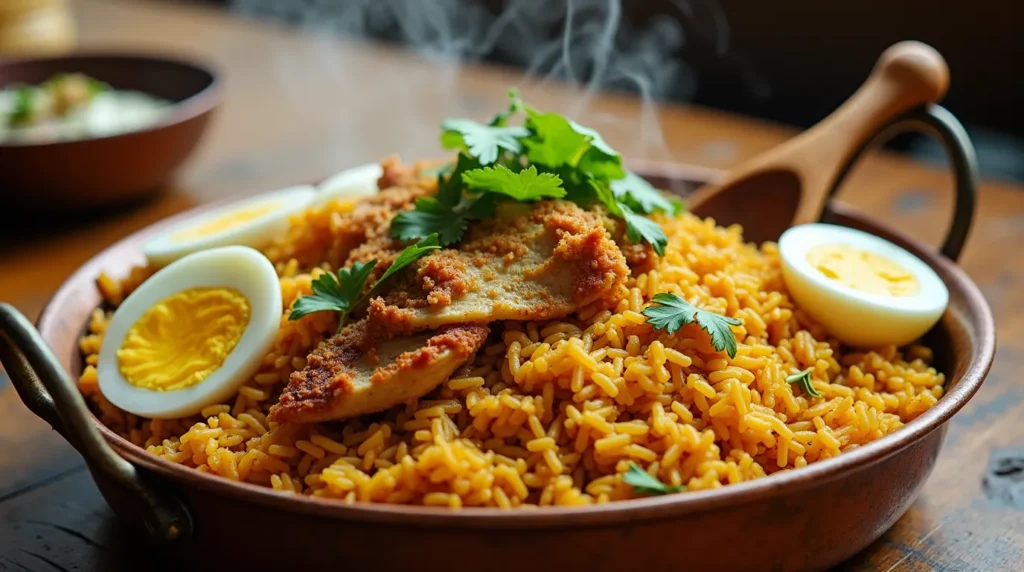
History and Characteristics: Biryani is said to have originated in the royal kitchens of the Mughal Empire, though local legends attribute different origins to it. Broadly, it is a layered rice dish involving marinated meat (or vegetables), fragrant basmati rice, and an array of spices. Cooked in a sealed pot (dum style) to trap steam, biryani is beloved for its complex flavors and aroma.
- Regional Variations:
- Hyderabadi Biryani (Telangana): Known for its spicy kick, often featuring marinated goat (mutton) or chicken.
- Lucknowi Biryani (Uttar Pradesh): Milder, relying more on aromatic spices and saffron, sometimes referred to as “pukki” biryani where the meat and rice are cooked separately before layering.
- Kolkata Biryani (West Bengal): Notable for its use of potatoes and subtle sweetness, reflecting regional preferences.
Simplified Recipe (Chicken Biryani)
- Marinate Chicken: In a bowl, combine 500g chicken pieces with yogurt, ginger-garlic paste, turmeric, chili powder, and salt. Let it rest for at least 1 hour.
- Prepare Rice: Parboil basmati rice (about 70% done).
- Fry Onions: In a large pot, fry sliced onions until golden brown. Keep half aside for garnish.
- Layering: Place the marinated chicken at the bottom of the pot, top with parboiled rice, drizzle with saffron-soaked milk (optional) and ghee. Add the fried onions saved earlier.
- Dum Cooking: Seal the pot with dough or aluminum foil, and cook on low heat for about 20–25 minutes until the chicken is cooked through and flavors meld.
- Serving: Fluff the rice gently with a fork and serve hot with raita (yogurt condiment).
2. Masala Dosa
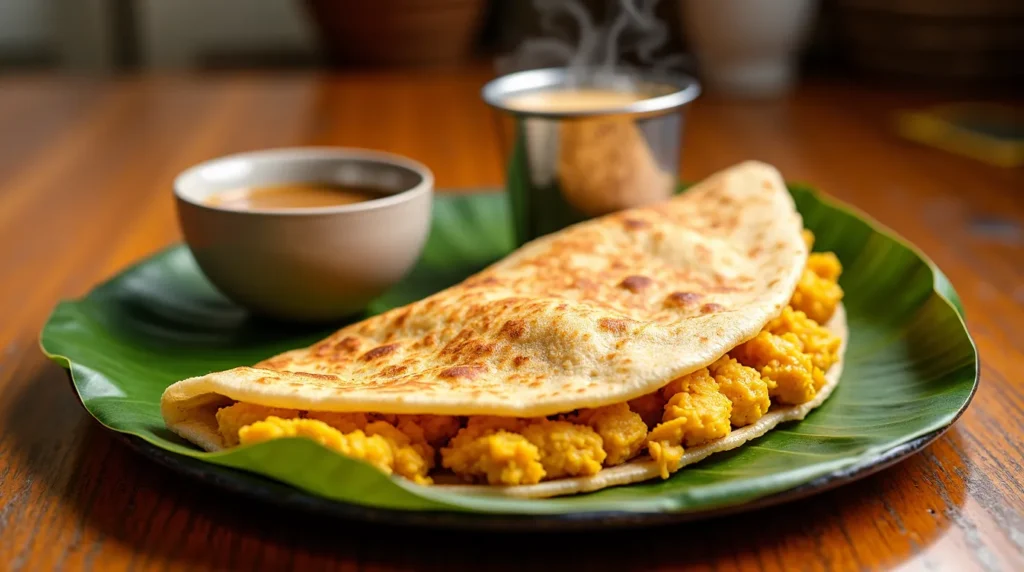
History and Characteristics: A hallmark of South Indian cuisine, dosa is a fermented crepe made from a blend of rice and urad dal (black gram). Its roots go back centuries, linked closely to temple cuisines and the vegetarian traditions of Tamil Nadu and Karnataka. The “masala” in masala dosa refers to a spiced potato filling.
How to Make a Basic Masala Dosa
- Batter Preparation: Soak 3 cups of rice and 1 cup of urad dal separately for 4–6 hours. Grind them together with a little water to form a smooth batter. Let the batter ferment overnight.
- Potato Filling: Cook potatoes, mash them, and sauté with mustard seeds, curry leaves, onions, and turmeric. Season with salt and a hint of chili if desired.
- Making the Dosa: Heat a flat pan or griddle. Spread a ladle of batter in a circular motion. Drizzle a few drops of oil around the edges. Once crisp and brown, place the potato filling in the center and fold.
- Serving: Serve with coconut chutney and sambar (spiced lentil soup).
3. Tandoori Chicken
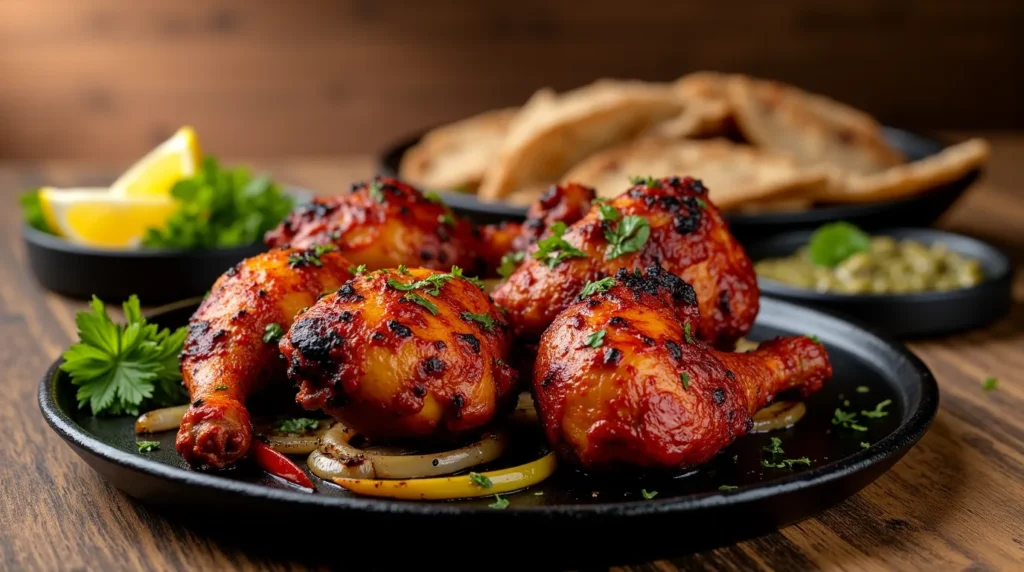
History and Characteristics: Tandoori chicken is iconic of North Indian Punjabi cuisine. The dish gets its name from the clay oven (tandoor) in which chicken is traditionally cooked. Marinated with yogurt and spices such as garam masala, red chili powder, and ginger-garlic paste, the chicken emerges smoky and beautifully charred.
Tip for Home Cooks: You can replicate the tandoor effect in a regular oven. Marinate the chicken overnight, then bake or grill it at a high temperature to achieve that smoky flavor. Serve with mint chutney and onion rings.
4. Chole Bhature
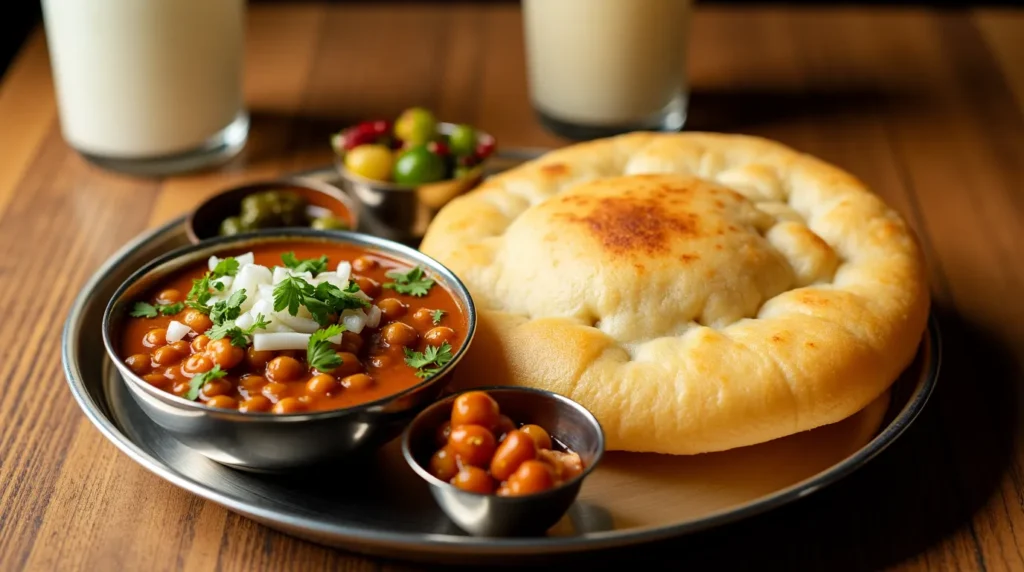
History and Characteristics: Chole (spiced chickpeas) paired with bhature (deep-fried leavened bread) is a breakfast or brunch staple in North India, particularly in Punjab. The chickpeas are slow-cooked in a tangy, spiced gravy featuring onions, tomatoes, and a proprietary blend of spices.
Regional Variation: While it’s closely associated with Punjab, different states have local twists, like adding pindi chole (a drier preparation) or garnishing with fresh chilies, onions, and a squeeze of lemon.
5. Rasgulla
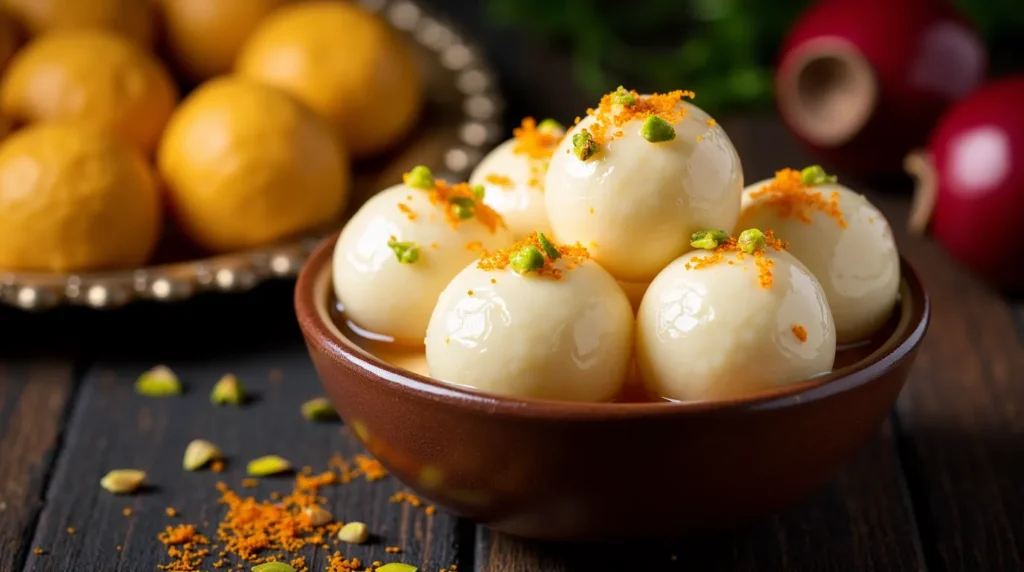
History and Characteristics: Eastern India is renowned for its sweets, and rasgulla is arguably the most famous. Originating in the state of Odisha (and also fiercely claimed by West Bengal), rasgulla is made from chhena (fresh curd cheese) shaped into balls and boiled in sugar syrup until they turn spongy and absorb the sweet liquid.
Serving Tip: Rasgulla is often served chilled, especially during festive occasions. Over time, variations such as rasmalai (rasgulla in sweetened, thickened milk) have also become extremely popular.
These dishes represent just a fraction of India’s culinary abundance. Each region boasts countless other specialties—idli, sambar, pav bhaji, vada pav, fish curry, kulfi, gulab jamun, rogan josh, dal makhani, and beyond. Exploring regional variations adds a deeper layer of discovery, showcasing how India’s geography and cultural mosaic finds expression in its food.
Defining Characteristics of Indian Cuisine
- Masterful Use of Spices: Contrary to popular belief, Indian cuisine is not solely about heat. It’s about layering flavors through judicious use of spices like cumin, coriander, turmeric, mustard seeds, and more. Each region uses a specific spice profile that sets its cuisine apart.
- Balancing Act: In many Indian dishes, the aim is to achieve a balance of tastes—salty, sweet, sour, bitter, spicy, and astringent—through the synergy of ingredients like spices, tamarind, jaggery (unrefined cane sugar), and yogurt.
- Vegetarian Tradition: A significant portion of India’s population follows vegetarian diets, primarily due to religious or cultural reasons (Hinduism, Jainism). This has led to a robust tradition of plant-based dishes, ensuring that Indian cuisine offers an unparalleled variety of flavorful vegetarian options.
- Regional Adaptations: India’s local cuisines have their own defining notes. For example, coconut imparts a creamy richness in southern Indian dishes, mustard oil provides a piquant taste in the east, and ghee (clarified butter) lends richness in the north.
- Why It Appeals to Food Enthusiasts: Foodies around the world adore Indian cuisine for its depth of flavor, aromatic spices, and boundless variety. Whether you’re seeking the heat of a vindaloo or the gentle sweetness of a korma, Indian dishes can captivate nearly every palate. The creativity with vegetarian dishes further appeals to those looking to explore plant-based cuisine without sacrificing flavor.
Tips and Highlights to Encourage People to Try This Cuisine
- Culinary Adventure: Indian cuisine is an invitation to explore bold flavors and unfamiliar spices. For those eager to expand their palate, trying new Indian dishes can be a thrilling experience.
- Cultural Significance: Food in India is intertwined with festivals, religious events, and everyday rituals. Trying Indian cuisine opens a door to understanding the country’s culture, values, and social customs. Many celebrations, like Diwali (Festival of Lights), revolve around sweet treats and special dishes that symbolize prosperity and good fortune.
- Social Enjoyment: Dining in India is often communal. Sharing a thali or sampling various dishes fosters a sense of togetherness, making Indian cuisine perfect for family gatherings and social events.
- Health Benefits: Many Indian dishes contain wholesome ingredients like lentils, vegetables, and spices with known health benefits. Turmeric, for instance, is recognized for its anti-inflammatory properties, while ginger aids digestion. Thus, Indian cuisine can be both flavorful and nutritious if prepared in a balanced manner.
- Adaptability: Most Indian recipes can be easily adapted to accommodate dietary restrictions. Whether you’re vegan, gluten-free, or have a preference for milder spice levels, Indian dishes offer flexible options without losing their essence.
Modern Trends and Culinary Fusions
- Integration of Global Cuisines: With increasing globalization, Indian cuisine now incorporates elements from Chinese, Thai, and Italian cuisines. “Indo-Chinese” food, for example, is a very popular adaptation characterized by dishes like Gobi Manchurian (cauliflower in a spicy sauce) and Hakka noodles spiced with Indian condiments.
- Health and Wellness Movements: As more Indians become health-conscious, there is a growing preference for organic produce, less oil, and minimal processing. Ayurveda-inspired cooking, focusing on the medicinal properties of spices and fresh ingredients, is also on the rise.
- Vegetarianism, Veganism, and Beyond: Given India’s ancient history of vegetarian diets, it’s not surprising that vegan restaurants and cafes are proliferating in urban centers. Chefs are reinventing traditional dishes to be entirely plant-based—using cashew cream instead of yogurt in curries, for instance.
- Farm-to-Table and Slow Food: Elite urban restaurants and boutique farms are championing the farm-to-table movement, highlighting local produce and traditional cooking techniques. This renewed emphasis on local sourcing aims to preserve indigenous crops and support sustainable agriculture.
- Young Chefs and Restaurateurs: A new generation of chefs is revisiting classic recipes and traditions in contemporary ways—combining them with international techniques or plating styles. This wave of innovation is evident in restaurants that serve inventive dishes like deconstructed samosas or fusion tacos filled with paneer tikka.
Conclusion and Call to Action
India’s cuisine stands at the crossroads of ancient culinary traditions, geographical diversity, and global influences. From the subtle flavors of Lucknow’s kebabs to the tangy fish curries of Bengal and the comforting aroma of masala chai, every bite tells a story shaped by centuries of trade, migration, and cultural exchange. We’ve journeyed through the historical backdrop of Indian gastronomy, examined regional nuances, identified key ingredients, and learned about iconic dishes like biryani, masala dosa, and tandoori chicken. We’ve also explored the defining characteristics—spice balancing, vegetarian heritage, and communal dining—and offered tips for purchasing ingredients and understanding table rituals.
For those eager to try Indian cuisine for the first time, consider experimenting with a simple lentil dal or a light vegetable curry. Don’t shy away from exploring local Indian restaurants or visiting an Indian market to immerse yourself in the aromas of fresh spices. If you’re already a fan, delve deeper into regional specialties—maybe try making a South Indian sambar from scratch or perfecting your own garam masala blend.
Above all, Indian cuisine is about sharing food and stories. Food enthusiasts, please share your experiences, favorite recipes, or questions in the comments. What dishes have you tried, and which would you like to learn more about? Have you discovered any fusion recipes that combine Indian flavors with other culinary traditions?
In a future article, we could explore the intricacies of Indian sweets and desserts, from the gulab jamun to the layered soan papdi, and their cultural significance during various festivals. Until then, continue to celebrate and explore the diverse and delicious realm of Indian food—there is always more to taste, learn, and enjoy.

